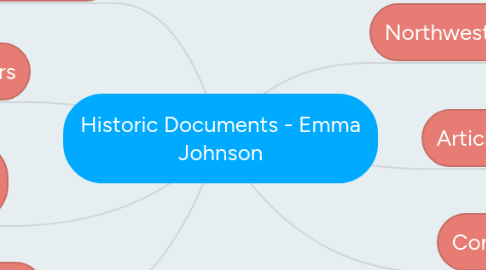
1. Bill of Rights
1.1. General Purpose
1.1.1. To provide inalienable rights to all citizens
1.2. Author and Important People
1.2.1. Author: James Madison Others: Anti-federalists
1.3. Time Frame of Significance
1.3.1. March 4, 1789 after ratification to present
1.4. Document Structure
1.4.1. First ten amendments of the Constitution
1.5. 5 Most Important Things
1.5.1. -Anti-federalists pushed for this so the people had more power than the government
1.5.2. -Nobody, including the government, can take away these rights
1.5.3. -They ensure that we have a right to a trial by jury and no excessive bail
1.5.4. -They protect our right to freedom of speech, religion, press, petition, and assembly
1.5.5. -It states that people do not have the right to random search and seizure without good reason
2. Declaration of Independence
2.1. General Purpose
2.1.1. To state that the colonies were independent of Great Britain
2.2. Author and Important People
2.2.1. Author: Thomas Jefferson Others: 56 representatives from the 13 colonies
2.3. Time Frame of Significance
2.3.1. July 4, 1776 to present
2.4. Document Structure
2.4.1. A long essay
2.5. 5 Most Important Things
2.5.1. It says that we each have rights to life liberty and the pursuit of happiness.
2.5.2. It stated that all men were created equal.
2.5.3. Created our Independence Day
2.5.4. The King was said to receive the document in 1778
2.5.5. 56 men signed the Dec. of Ind., two of which would become presidents in the future
3. Anti-Federalist Papers
3.1. General Purpose
3.1.1. To argue against the ratification of the Constitution. They did not want a federalist government
3.2. Author and Important People
3.2.1. Many anti-federalists who often wrote under fake names
3.3. Time Frame of Significance
3.3.1. From 1787 to 1789 when the Constitution was ratified
3.4. Document Structure
3.4.1. In the form of articles and papers to essays to speeches and pretty much all of the above
3.5. 5 Most Important Things
3.5.1. -They thought the states should have more power than the federal government
3.5.2. -They didn't want the federal government to have power
3.5.3. -They pushed for the Bill of Rights
3.5.4. -They believed that each person should have individual rights
3.5.5. -They hated the federalists
4. Federalist Papers
4.1. General Purpose
4.1.1. To encourage the power of the federal government
4.2. Author and Important People
4.2.1. Many federalists who wrote under false names
4.3. Time Frame of Significance
4.3.1. Between when the Constiturion was adopted and when it was ratified
4.4. Document Structure
4.4.1. Anything from newspaper articles to speeches and essays.
4.5. 5 Most Important Things
4.5.1. -Used to persuade people towards a more federal government
4.5.2. -Wanted to give less power to the states
4.5.3. -They wanted more power given to the federal government
4.5.4. -They didn't think a Bill of Rights was neccessary
4.5.5. -They disliked the Anti-federalists
5. Constitution
5.1. General Purpose
5.1.1. To govern the United States of America more effectively than the Articles of Confederation
5.2. Author and Important People
5.2.1. Author: James Madison Others: Delegates of the states
5.3. Time Frame of Significance
5.3.1. Enforced: March 4, 1789 to present
5.4. Document Structure
5.4.1. Comprised of the Preamble, Bill of Rights (first ten amendments), seven articles, and currently 27 amendments
5.5. 5 Most Important Things
5.5.1. -They learned from the Articles
5.5.2. -Consisted of two plans: the New Jersey Plan and the Virginia Plan. A third was completely rejected: the Hamilton Plan
5.5.3. -Created a government that included three branches of government: the legislative, executive, and judicial
5.5.4. -The legislative was made up of two houses: the Senate and the House of Representatives for more equality and voting rights of the smaller states
5.5.5. -The Bill of Rights was added to ensure inalienable rights to all citizens
6. Northwest Ordinance
6.1. General Purpose
6.1.1. To provide a way of admitting states into the Union from a territory. Specifically the Northwest Territory. Paved a way to expand westward.
6.2. Author and Important People
6.2.1. Authors: Nathan Dane and Rufus King Others: Thomas Jefferson who proposed a similar paper in 1784
6.3. Time Frame of Significance
6.3.1. July 13, 1787 to present
6.4. Document Structure
6.4.1. As a long proposal/essay written in old English
6.5. 5 Most Important Things
6.5.1. -Guaranteed that new states would be equal to the original thirteen
6.5.2. -There must be 60,000 residents in the territory before requesting to be admitted to the Union
6.5.3. -Each territory must have a state constitution and a bill of rights
6.5.4. -Must have a congressionally appointed governor, secretary, and three judges
6.5.5. -Slavery was forbidden in the Northwest Territory
7. Articles of Confederation
7.1. General Purpose
7.1.1. To govern the new found United States of America
7.2. Author and Important People
7.2.1. Author: John Dickinson Others: Members of the Continental Congress
7.3. Time Frame of Significance
7.3.1. Adopted: Nov. 15, 1777 Enforced: March 1,1781 to 1789
7.4. Document Structure
7.4.1. Broken into Articles, each on a specific topic
7.5. 5 Most Important Things
7.5.1. -They were unable to efficiently govern the country
7.5.2. -They could not collect taxes
7.5.3. -They could not regulate trade between states
7.5.4. -It was their first attempt to govern the people... hopefully they learned from it
7.5.5. -It failed!
